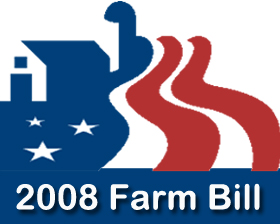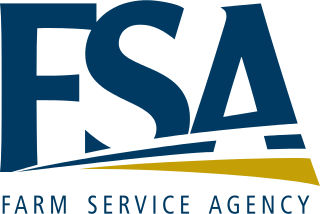
A government budget is a financial statement presenting the government's proposed revenues and spending for a financial year. The government budget balance, also alternatively referred to as general government balance, public budget balance, or public fiscal balance, is the overall difference between government revenues and spending. A positive balance is called a government budget surplus, and a negative balance is a government budget deficit. A budget is prepared for each level of government and takes into account public social security obligations.
Crop insurance is purchased by agricultural producers, and subsidized by the federal government, to protect against either the loss of their crops due to natural disasters, such as hail, drought, and floods, or the loss of revenue due to declines in the prices of agricultural commodities. The two general categories of crop insurance are called crop-yield
insurance and crop-revenue insurance. On average, the federal government subsidizes 62 percent of the premium. In 2014, crop insurance policies covered 294 million acres. Major crops are insurable in most counties where they are grown, and approximately 83% of U.S. crop acreage is insured under the federal crop insurance program. Four crops—corn, cotton, soybeans, and wheat— typically account for more than 70% of total enrolled acres. For these major crops, a large share of plantings is covered by crop insurance. In 2014, the portion of total corn acreage covered by federal crop insurance was 87%; cotton, 96%; soybeans, 88%; and wheat, 84%.

The Federal Agriculture Improvement and Reform Act of 1996, known informally as the Freedom to Farm Act, the FAIR Act, or the 1996 U.S. Farm Bill, was the omnibus 1996 farm bill that, among other provisions, revises and simplifies direct payment programs for crops and eliminates milk price supports through direct government purchases.
On the eve of the 1921 revolution, Mongolia had an underdeveloped, stagnant economy based on nomadic animal husbandry. Farming and industry were almost nonexistent; transportation and communications were primitive; banking, services, and trade were almost exclusively in the hands of Chinese or other foreigners. Most of the people were illiterate nomadic herders, and a large part of the male labour force lived in the monasteries, contributing little to the economy. Property in the form of livestock was owned primarily by aristocrats and monasteries; ownership of the remaining sectors of the economy was dominated by Chinese or other foreigners. Mongolia's new rulers thus were faced with a daunting task in building a modern, socialist economy.

In the United States, the farm bill is the primary agricultural and food policy tool of the federal government. The comprehensive omnibus bill is renewed every 5 years or so and deals with both agriculture and all other affairs under the purview of the United States Department of Agriculture.

The Food, Conservation, and Energy Act of 2008 was a $288 billion, five-year agricultural policy bill that was passed into law by the United States Congress on June 18, 2008. The bill was a continuation of the 2002 Farm Bill. It continues the United States' long history of agricultural subsidies as well as pursuing areas such as energy, conservation, nutrition, and rural development. Some specific initiatives in the bill include increases in Food Stamp benefits, increased support for the production of cellulosic ethanol, and money for the research of pests, diseases and other agricultural problems.
The Brazil–United States cotton dispute was a World Trade Organization dispute settlement case (DS267) on the issue of unfair subsidies on cotton. In 2002, Brazil—a major cotton export competitor—expressed its growing concerns about United States cotton subsidies by initiating a WTO dispute settlement case against certain features of the U.S. cotton program. On March 18, 2003, a Panel was established to adjudicate the dispute. Argentina, Canada, China, Chinese Taipei, the European Communities, India, Pakistan, and Venezuela participated as third parties. Focusing on six specific claims relating to US payment programmes, Brazil argued that the US had failed to abide by its commitments
in the Uruguay Round Agreement on Agriculture (AoA) and the Agreement on Subsidies and Countervailing Measures (SCM). On September 8, 2004, a WTO dispute settlement (DS) panel ruled against the United States on several key issues in case.
The Agricultural Market Transition Act (AMTA) — Title I of the 1996 farm bill — allowed farmers who had participated in the wheat, feed grain, cotton, and rice programs in any one of the 5 years prior to 1996 to enter into 7-year production flexibility contracts for 1996-2002. Total national production flexibility contract payments for each fiscal year were fixed in the law. The AMTA allowed farmers to plant 100% of their total contract acreage to any crop except fruits and vegetables, and receive a full payment. Land had to be maintained in agricultural uses. Unlimited haying and grazing and planting and harvesting alfalfa and other forage crops was permitted with no reduction in payments. AMTA commodity support provisions were replaced by the 2002 farm bill, a 6-year farm bill.
In United States agricultural law, a farm’s base acreage is its crop-specific acreage of wheat, corn, grain sorghum, barley, oats, upland cotton, soybeans, canola, flax, mustard, rapeseed, safflower, sunflowers, and rice eligible to enroll in the Direct and Counter-cyclical Program (DCP) under the 2002 farm bill. A farmer’s crop acreage base is reduced by the portion of cropland placed in the Conservation Reserve Program (CRP), but increased by CRP base acreage leaving the CRP. Farmers have the choice of base acreage used to calculate Production Flexibility Contract payments for crop year 2002, or the average of acres planted for crop years 1998 through 2001.
Contract acreage — Base acres enrolled annually in the Direct and Counter-cyclical Program (DCP) authorized by the 2002 farm bill for covered commodities during crop years 2002 through 2007. Previously, the 1996 farm bill authorized 7-year production flexibility contracts, which guaranteed fixed direct payments but not counter-cyclical target price deficiency payments. The new law uses the term agreement rather than contract, but farmers must sign a Direct and Counter-cyclical Program Contract.
Counter-cyclical payment (CCP) — Under the Direct and Counter-cyclical Program (DCP) created by the 2002 farm bill, counter-cyclical payments are made to participating producers when the marketing year average price received by farmers for a covered commodity is less than the target price. The total payment to a producer is the payment acres times the payment rate.
In the United States, deficiency payments are direct government payments made to farmers who participated in annual commodity programs for wheat, feed grains, rice, or cotton, prior to 1996.
In United States agricultural policy, the triple base plan -- also called the flexible base plan -- is a proposal under which farmers who raise program crops would receive program payments only on a certain percentage of their permitted acreage. A producer participating in a federal price support program actually would have three categories of base acres for program purposes:
In the United States, a production flexibility contract is a 7-year contract covering crop years 1996-2002, authorized by the 1996 farm bill between the Commodity Credit Corporation (CCC) and farmers, which makes fixed income support payments. Farmers were given production flexibility and diversification options on their contract acres not previously allowed on base acres. Each farm’s total payment was the payment rate times the payment quantity for participating base acres. In exchange for annual fixed payments, the owner or operator agreed to comply with the applicable conservation plan for the farm, the wetland protection requirements currently in law, and the constraints on growing fruits and vegetables on contract acres. Land enrolled in a contract had to be maintained in an agricultural or related activity. The law stated that not more than $35.6 billion would be paid over the 7-year period, in declining annual amounts from $5.3 billion in FY1996 to $4.0 billion in FY in 2002. The annual payments were allocated among commodities similar to historical deficiency payments, with 53.6% going to feed grains, 26.3% for wheat, 11.6% for upland cotton, and 8.5% for rice. Target prices and deficiency payments, authorized in the 1973 farm bill, were eliminated. The 2002 farm bill replaced this 7-year contract with an annual producer agreement (contract) required for participation in the Direct and Counter-cyclical Program (DCP).
The Direct and Counter-cyclical Payment Program (DCP) of the USDA provides payments to eligible producers on farms enrolled for the 2002 through 2007 crop years. There are two types of DCP payments – direct payments and counter-cyclical payments. Both are computed using the base acres and payment yields established for the farm.
In United States agricultural policy, the payment limitation refers to the maximum annual amount of farm program benefits a person can receive by law.
The 2002 farm bill replaced the longtime (65-year) support program for peanuts with a framework identical in structure to the program for the so-called covered commodities. The three components of the Peanut Price Support Program are fixed direct payments, counter-cyclical payments, and marketing assistance loans or loan deficiency payments (LDPs). The peanut poundage quota and the two-tiered pricing features of the old program were repealed. Only historic peanut producers are eligible for the Direct and Counter-cyclical Program (DCP). All current production is eligible for marketing assistance loans and LDPs. Previous owners of peanut quota were compensated through a buy-out
program at a rate of 55¢/lb. ($1,100/ton) over a 5-year period.
Milk Income Loss Contract (MILC) Payments is the name given by USDA to the dairy farmer counter-cyclical payments program, authorized by the 2002 farm bill. Under the program, dairy farmers nationwide are eligible for a federal payment whenever the minimum monthly market price for farm milk used for fluid consumption in Boston falls below $16.94/cwt. A producer potentially can receive a payment equal to 45 percent of the difference between the $16.94 per cwt. target price and the market price, in any month that the Boston market price falls below $16.94. A producer can receive a payment on all milk production during that month, but no payments will be made on any annual production in excess of 2.4 million pounds per dairy operation. On average this limit is reached by a milking herd of 130 cows. MILC payments apply to production beginning December 1, 2002 through September 30, 2012.

A Limited Resource Farmer or Rancher is one of a larger group of “targeted farmers" that also includes beginning farmers and ranchers and socially disadvantaged farmers and ranchers. Limited Resource Farmers are characterized by having limited farm sales and income. The USDA created the Limited Resource Farmer and Rancher program to ensure that these farmers and ranchers can develop economically viable farms, have access to USDA support, and ensure that programs are in alignment with farmer and rancher needs and concerns.
In Canadian agricultural policy, a Gross Revenue Insurance Plan (GRIP) is a form of direct payment combining a crop insurance component and a revenue protection component. Farmers finance one-third of the premiums paid out under the revenue protection component. The GRIP makes payments when market revenue falls short of a producer’s target revenue. Target revenue per acre for an individual crop is based on historical yields, a multi-year moving average of price, and a level of insurance coverage chosen by the producer.





